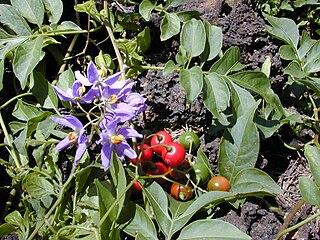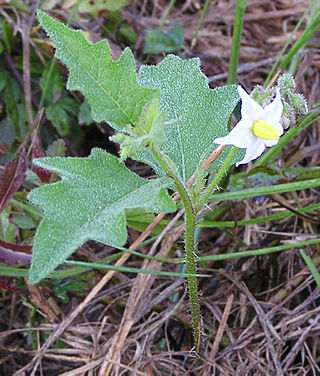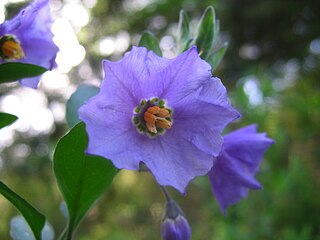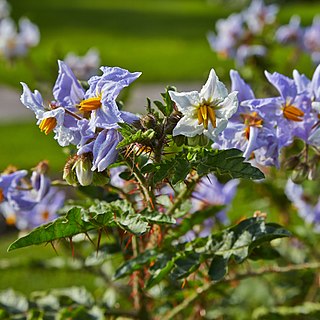
Solanum is a large and diverse genus of flowering plants, which include three food crops of high economic importance: the potato, the tomato and the eggplant. It is the largest genus in the nightshade family Solanaceae, comprising around 1,500 species. It also contains the so-called horse nettles, as well as numerous plants cultivated for their ornamental flowers and fruit.

Solanum carolinense, the Carolina horsenettle, is not a true nettle, but a member of the Solanaceae, or nightshade family. It is a perennial herbaceous plant, native to the southeastern United States, though its range has expanded throughout much of temperate North America. The plant is an invasive in parts of Europe, Asia, Africa and Australia. The stem and undersides of larger leaf veins are covered with prickles.

Solanum dulcamara is a species of vine in the genus Solanum of the family Solanaceae. Common names include bittersweet, bittersweet nightshade, bitter nightshade, blue bindweed, Amara Dulcis, climbing nightshade, felonwort, fellenwort, felonwood, poisonberry, poisonflower, scarlet berry, snakeberry, trailing bittersweet, trailing nightshade, violet bloom, and woody nightshade.

Solanum mauritianum is a small tree or shrub native to South America, including Northern Argentina, Southern Brazil, Paraguay and Uruguay. Its common names include earleaf nightshade, woolly nightshade, flannel weed, bugweed, tobacco weed, tobacco bush, wild tobacco and kerosene plant.

Solanum americanum, commonly known as American black nightshade, small-flowered nightshade or glossy nightshade, is a herbaceous flowering plant of wide though uncertain native range. The certain native range encompasses the tropics and subtropics of the Americas, Melanesia, New Guinea, and Australia.

Solanum mammosum, commonly known as nipplefruit, fox head, cow's udder, or apple of Sodom, is an inedible Pan-American tropical fruit. The plant is grown for ornamental purposes, in part because of the distal end of the fruit's resemblance to a human breast, while the proximal end looks like a cow's udder. It is an annual in the family Solanaceae, and part of the genus Solanum, making the plant a relative of the eggplant, tomato, and potato. This poisonous fruit is native to South America, but has been naturalized in Southern Mexico, Greater Antilles, Central America, and the Caribbean. The plant adapts well to most soils, but thrives in moist, loamy soil.

Lycopersicon was a genus in the flowering plant family Solanaceae. It contained about 13 species in the tomato group of nightshades. First removed from the genus Solanum by Philip Miller in 1754, its removal leaves the latter genus paraphyletic, so modern botanists generally accept the names in Solanum. The name Lycopersicon is still used by gardeners, farmers, and seed companies. Collectively, the species in this group apart from the common cultivated plant are called wild tomatoes.

Solanum umbelliferum is a species of nightshade known commonly as bluewitch nightshade, or bluewitch. It can be found in chaparral habitat and low-elevation oak woodlands in California and parts of Baja California and Arizona. It is a small perennial herb or subshrub with dark gray-green oval-shaped leaves on hairy green stems that grow to a maximum height of one meter. It has bright purple or blue frilly flowers with thick yellow anthers at the center. The flowers close into spherical buds overnight. It bears small round green fruits which turn purple when ripe and resemble tiny eggplants.

Solanum xanti, known commonly as chaparral nightshade, purple nightshade, and San Diego nightshade, is a member of the genus Solanum. It is native to the Western United States in Arizona, California, Nevada, and Oregon, and to northwest Mexico in Baja California.

Solanum sisymbriifolium is commonly known as vila-vila, sticky nightshade, red buffalo-bur, the fire-and-ice plant, litchi tomato, or Morelle de Balbis.

Solanum citrullifolium is a species of flowering plant in the Solanaceae family. It is a nightshade referred to by the common name watermelon nightshade, as its leaves somewhat resemble those of a watermelon plant. It is a white-stemmed shrub with purple star-shaped flowers. It is native to the southern United States and it is grown in home gardens as an ornamental plant.

Solanum lanceolatum, with the common names orangeberry nightshade and lanceleaf nightshade, is a species of nightshade. It is native to regions of South America, including the Cerrado ecoregion of the Tropical and subtropical grasslands, savannas, and shrublands biome, primarily in Brazil.

Solanum seaforthianum, the Brazilian nightshade, is a flowering evergreen vine of the family Solanaceae native to tropical South America. As a member of the Solanum genus, it is related to such plants as the tomato and potato. It is characterized by clusters of four to seven leaves and can climb to a height of 6 m (20 ft) given enough room. It blooms in the mid to late summer with clusters of star-shaped purple inflorescence followed by scarlet marble-sized berries. The plant is highly heat resistant, but cannot tolerate frost conditions. The plant contains modest amounts of various tropane alkaloids such as atropine, scopolamine and hyoscyamine and should be considered mildly toxic and inedible. Promising molluscicidal and schistosomicidal activities were displayed for the S. seaforthianum extracts and fractions which are attributed to the glycoalkaloid content.
Solanum dimidiatum is a species of plant in the family Solanaceae known by the common names western horsenettle, Torrey's nightshade, and robust horsenettle. It is native to the central United States, where it grows in many types of habitat, including disturbed areas. In California it is known as an introduced species and a noxious weed. It is a rhizomatous perennial herb producing an erect stem up to 80 centimeters tall. It is covered in yellow prickles and branched hairs. The leaves may be up to 15 centimeters long, their edges wavy to lobed and sometimes toothed. The inflorescence is a branching array of several flowers. Each flower has a bell-shaped corolla measuring 3 to 5 centimeters wide. It is lavender to purple, or white. The five large, yellow anthers are about a centimeter long. The fruit is a spherical yellow berry up to 3 centimeters wide.

Solanum marginatum is a species of plant in the family Solanaceae known by the common names purple African nightshade and white-margined nightshade. It is native to Ethiopia and Eritrea, and it is known on other continents as an introduced species and sometimes a weed. It is a hairy shrub growing up to two meters tall. The large, distinctive, gray-green leaves are wavy along the edges, woolly on the undersides, and measure up to 18 centimeters long. The veins are white and lined with large, widely spaced prickles. The inflorescence contains several white flowers, hanging or nodding bisexual flowers and erect staminate flowers with large yellow anthers. The fruit is a yellow berry up to 5 centimeters wide.

Solanum parishii is a species of nightshade known by the common name Parish's nightshade. It is native to western North America from Oregon to Baja California, where it grows in many types of habitat, including maritime and inland chaparral, woodlands, and forests. It is a perennial herb or subshrub producing a branching, ribbed or ridged stem up to about a meter in maximum height. The lance-shaped to nearly oval leaves are up to 7 centimeters long and smooth-edged or somewhat wavy. The inflorescence is an umbel-shaped array of several flowers, each borne on a short pedicel. The flower corolla is around 2 centimeters wide when fully open and is usually purple, but sometimes white. At the center are yellow anthers. The fruit is a berry roughly a centimeter wide.
Solanum triflorum is a species of nightshade, in the family Solanaceae, also known as cutleaf nightshade and small nightshade. Like many nightshades, S. triflorum is native to South America, specifically to Argentina; it has made its way onto other continents, including Europe and Australia, as an introduced species, where it is deemed a weed, at times. It is also typically considered native to much of the Eastern and Western parts of the United states and parts of Canada, although there is some debate on the matter. It grows in many types of habitats, preferring tilled, disturbed terrain for germinating. It is an annual herb, producing sprawling, decumbent stems dotted with new growth. These decumbent, horizontal stems may quickly grow up to a meter in all directions. Solanum triflorum is covered in trichomes and hairs, which are sometimes mistaken for glands. The leaves are a few centimeters long, and deeply “cut” into slightly pointed, serrated lobes, garnering its common name, “cutleaf”. The inflorescence bears two or three flowers, each just under a centimeter wide when fully open. The flower is usually white, but may be greenish or purple-tinged. The fruit is a berry, similar to the nightshade family, roughly a centimeter wide.
Solanum candidum is a species of evergreen shrub native to South America and occasionally grown for its edible fruit.

Solanum sandwicense is a rare species of flowering plant in the nightshade family known by the common names Hawai'i horsenettle and popolo 'aiakeakua. It is endemic to Hawaii, where it occurs today on the islands of Kauai and Oahu. It is threatened by the destruction and degradation of its habitat. It is a federally listed endangered species of the United States.
Solanum clokeyi, known as Clokey's nightshade, Island nightshade, or Santa Cruz Island nightshade, is a species of flowering plant in the nightshade family endemic to California, United States. It occurs in southeastern California, including the Channel Islands and Santa Catalina Island. The name honors American botanist Ira Waddell Clokey. It is sometimes treated as a synonym or variety of Solanum wallacei.
















